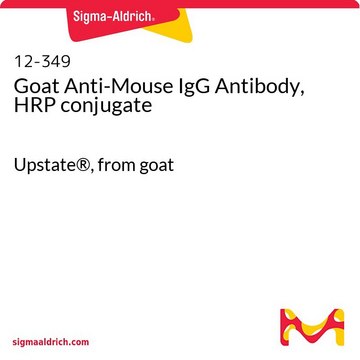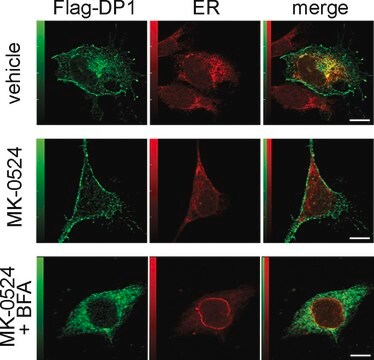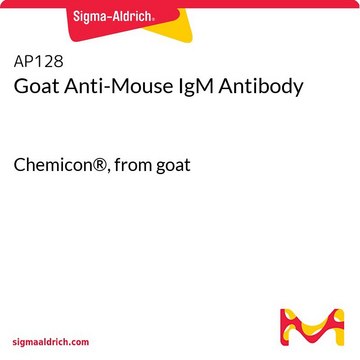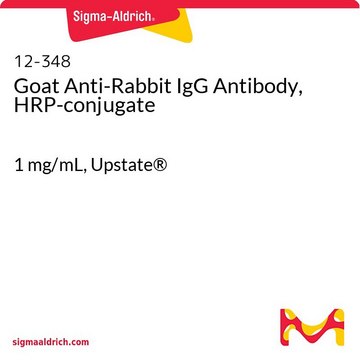AP160
Rabbit Anti-Mouse IgG Antibody
2.4 mg/mL, Chemicon®
Synonym(s):
IgG antibody
Sign Into View Organizational & Contract Pricing
All Photos(1)
About This Item
UNSPSC Code:
12352203
eCl@ss:
32160702
NACRES:
NA.46
Recommended Products
biological source
rabbit
Quality Level
conjugate
unconjugated
antibody form
purified immunoglobulin
clone
polyclonal
species reactivity
mouse
manufacturer/tradename
Chemicon®
concentration
2.4 mg/mL
technique(s)
ELISA: suitable
immunoprecipitation (IP): suitable
western blot: suitable
shipped in
wet ice
target post-translational modification
unmodified
Related Categories
Specificity
Reacts with Mouse IgG gamma chain, as well as the light chains from all Mouse immunoglobulin classes. Monospecific on IEP against whole Mouse Serum.
Immunogen
Highly purified Mouse IgG isolated from pooled normal Mouse Serum.
Application
Detect Mouse IgG using this Rabbit anti-Mouse IgG Antibody validated for use in ELISA, IP & WB.
Research Category
Secondary & Control Antibodies
Secondary & Control Antibodies
Research Sub Category
Whole Immunoglobulin Secondary Antibodies
Whole Immunoglobulin Secondary Antibodies
Storage and Stability
Store at +2-8°C. Do not freeze.
Legal Information
CHEMICON is a registered trademark of Merck KGaA, Darmstadt, Germany
Disclaimer
Unless otherwise stated in our catalog or other company documentation accompanying the product(s), our products are intended for research use only and are not to be used for any other purpose, which includes but is not limited to, unauthorized commercial uses, in vitro diagnostic uses, ex vivo or in vivo therapeutic uses or any type of consumption or application to humans or animals.
Storage Class Code
12 - Non Combustible Liquids
WGK
nwg
Flash Point(F)
Not applicable
Flash Point(C)
Not applicable
Certificates of Analysis (COA)
Search for Certificates of Analysis (COA) by entering the products Lot/Batch Number. Lot and Batch Numbers can be found on a product’s label following the words ‘Lot’ or ‘Batch’.
Already Own This Product?
Find documentation for the products that you have recently purchased in the Document Library.
Collateral projection from the locus coeruleus to whisker-related sensory and motor brain regions of the rat.
Sat-Byol Lee,Suk K Beak,Seung H Park,Barry D Waterhouse,Hyun S Lee
The Journal of Comparative Neurology null
Immunohistochemical localization of DARPP-32 in the brain and spinal cord of anuran amphibians and its relation with the catecholaminergic system.
Jesus M Lopez,Ruth Morona,Agustin Gonzalez
Journal of Chemical Neuroanatomy null
Kari Vaahtomeri et al.
Journal of cell science, 121(Pt 21), 3531-3540 (2008-10-09)
Inactivating mutations of the tumor-suppressor kinase gene LKB1 underlie Peutz-Jeghers syndrome (PJS), which is characterized by gastrointestinal hamartomatous polyps with a prominent smooth-muscle and stromal component. Recently, it was noted that PJS-type polyps develop in mice in which Lkb1 deletion
Yao-Ming Wu et al.
Cell transplantation, 19(9), 1169-1180 (2010-04-24)
Hepatocyte transplantation (Tx) holds promise for curing genetic liver diseases. However, a limited number of donor hepatocytes can be transplanted into the host liver. Recipient preconditioning and donor cell engineering are under investigation to improve cell engraftment. In theory, genetically
Our team of scientists has experience in all areas of research including Life Science, Material Science, Chemical Synthesis, Chromatography, Analytical and many others.
Contact Technical Service








